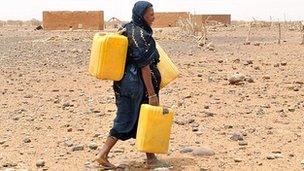Harrabin's Notes: Safe assumptions
- Published
Put the champagne away! It seems that the number of people in the world without drinking water may be as much as five times higher than the UN has stated.
SAFE ASSUMPTIONS
It's miserable to be a party-wrecker, but it appears that the UN's recent achievement on global targets for safe drinking water isn't quite as impressive as it sounds.

Is the number of people without access to safe drinking water much higher than the UN reports?
The UN recently trumpeted: "The goal of reducing by half the number of people without access to safe drinking water has been achieved, well ahead of the 2015 deadline (set under Millennium Development Goals)."
It was a welcome piece of good news for the Secretary-General, Ban Ki-moon.
In two decades to 2010, more than two billion people got safe drinking water, leaving "only" 800 million people with potentially unsafe drinking water. The 800 million figure is still huge.
But, it appears, the real number of people without guaranteed access to safe drinking water is greater still; apparently as much as five times greater.
Who says so? Well, the man who deals with the statistics at the World Health Organization (WHO). Members of the Secretary General's own independent advisory group on water, known as UNSGAB, have also voiced their concerns.
I understand some of them have let Mr Ban know in no uncertain terms that his office has badly understated the scale of the drinking water crisis.
The UN's technical experts and advisers alike estimate that the true number of people without reliably safe drinking water is between one and four billion people. The latter figure is more than half the world's population.
<bold>'Slippery terminology'</bold>
So has someone blundered? Well, it appears to be a question of slippery terminology rather than dodgy numbers.
The WHO's co-ordinator of water and sanitation, Robert Bos, told me that the problem began with the definition of the goal agreed by politicians on the MDGs to "halve the proportion of people by 2015 without sustainable access to safe drinking water".
"The trouble is," he said, "that the politicians didn't consult the people who would have to measure it.
"We have no idea what sustainable means - and we have no data on clean drinking water.
"What we do have is household survey data on access to improved drinking water - that means piped supplies or a protected well.
"We can make an assumption that it's more safe than drinking from an unprotected pond shared with animals but we can't say for sure whether that water is safe or not."
So the terminology Mr Ban should have used for the celebratory water announcement was that people had "improved" water, not "safe" water.
Mr Bos went on: "The secretary-general got very excited when he heard that the target for improved water supplies had been met early - you can understand why.
"We presented the data in the correct way but somehow it got muddled up in the communication within the UN system.
"If people really think the 800 million figure refers to people lacking safe drinking water that's definitely an under-estimate. We don't know the real number but it's probably something between one and four billion."
The problem is many of the water sources that count as "improved" are still not safe. For instance, piping water to a village tap counts as "improving" the supply - even if the tap brings bacteria-laden water untreated straight from a river.
To find out the true number of people without safe drinking water the UN would have to do costly research, which, Mr Bos says, donors avoid because they prefer to pay for improvements to water supplies themselves.
The UN did some of its own survey work. It showed that in Jordan almost all improved supplies were actually safe to drink - but that in Nicaragua 70% of improved supplies could still make people sick.
Extrapolating from patchy national data, the World Bank estimates that, globally, the number of people drinking bad water is upwards of three billion.
Gerard Payen, a member of United Nation Secretary-General's Advisory Board on Water and Sanitation (UNSGAB), says this is the figure that should be on people's lips, not 800 million.
"I was very pleased that the UN has brought down the number of people with 'unimproved' water to 800 million," he told me.
"This is a considerable achievement. But it's a pity that so many people think that's the real total of people drinking unsafe water, when the true figure is 3-4 times higher."
Mr Payen represents private water companies so some people within the UN say he has a predictable angle on this debate.
But Julia Bucknall, head of the World Bank's Water Unit, confirmed: "The number of people who lack access to safe water you can drink from the tap is probably around three billion, we can't be sure - certainly it's way more than 800 million.
"To be in the 21st Century while we are in this situation is a scandal."
So, the good news on access to clean water isn't as good as it appears.
Meanwhile Mr Bos and his colleagues have been trying to get one step ahead of the politicians for the next set of development goals from 2015.
WHO has started to measure its own statistics in its own way - and it's hoping to guide politicians towards measuring things that can actually be measured to avoid this sort of confusion in the future.
- Published22 December 2011
- Published17 August 2011
- Published7 July 2011
- Published11 January 2011
- Published13 December 2010
- Published9 December 2010